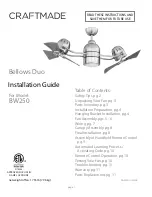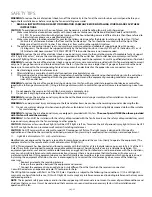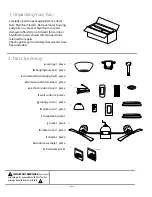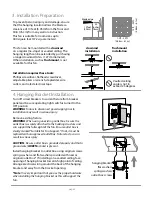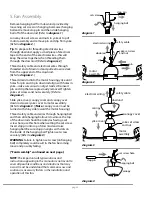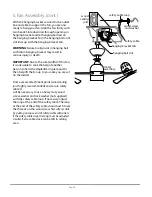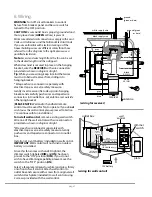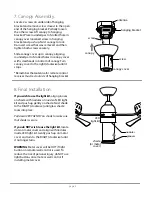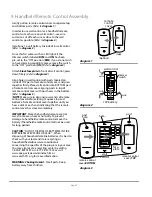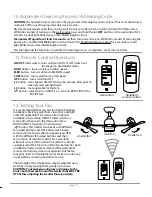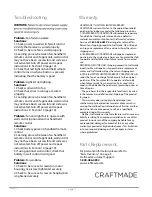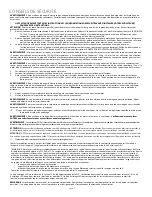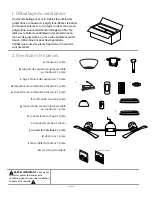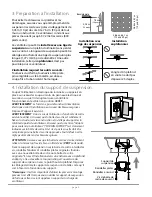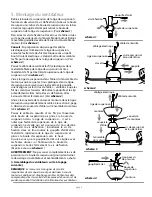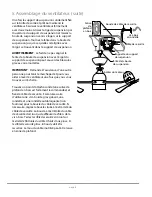
WARNING
: To reduce the risk of electrical shock, turn off the electricity to the fan at the main fuse box or circuit panel before you
begin the fan installation or before servicing the fan or installing accessories.
1.
READ ALL INSTRUCTIONS AND SAFETY INFORMATION CAREFULLY BEFORE INSTALLING YOUR FAN AND SAVE THESE
INSTRUCTIONS.
CAUTION
: To avoid personal injury, the use of gloves may be necessary while handling fan parts with sharp edges.
2. Make sure all electrical connections comply with Local Codes or Ordinances, the National Electrical Code, and ANSI/NFPA
70-1999. If you are unfamiliar with electrical wiring or if the house/building wires are different colors than those referred to
in the instructions, please use a qualified electrician.
3. Make sure you have a location selected for your fan that allows clear space for the blades to rotate, and at least ten (10) feet
(3.05 meters) of clearance between the floor and the fan blade tips. The fan should be mounted so that the tips of the
blades are at least thirty (30) inches (76 centimeters) from walls or other upright structures.
4. The outlet box and ceiling support joist used must be securely mounted, and capable of supporting at least 35 pounds
(16 kilograms). The box must be supported directly by the building structure. Use only CETL or CUL (Canada) or ETL or UL
(USA) listed outlet boxes marked "FOR FAN SUPPORT." Plastic outlet boxes are not recommended.
WARNING
: To reduce the risk of fire, electrical shock, or personal injury, mount to the outlet box marked "Acceptable for Fan Support
of 15.9 kg (35 lb) or less," and use the mounting screws provided with the outlet box. Most outlet boxes commonly used for the
support of lighting fixtures are not acceptable for fan support and may need to be replaced. Consult a qualified electrician if in doubt.
WARNING
: To reduce the risk of fire, electrical shock, or personal injury, wire connectors provided with this fan are designed to accept
only one 12 gauge house wire and two lead wires from the fan. If your house wire is larger than 12 gauge or there is more than one
house wire to connect to the corresponding fan lead wires, consult an electrician for the proper size wire connectors to use.
5. Electrical diagrams are for reference only.
6. After installation is complete, check that all connections are absolutely secure.
7. After making electrical connections, spliced conductors should be turned upward and pushed carefully up into the outlet box.
The wires should be spread apart with the grounded conductor and the equipment-grounding conductor on opposite
sides of the outlet box.
WARNING
: To reduce the risk of fire or electrical shock, do not use this fan with any solid state speed control device or control fan
speed with a full range dimmer switch. [Using a full range dimmer switch to control fan speed will cause a loud humming noise from
fan.]
8. Do not operate the reverse switch until fan has come to a complete stop.
9. Do not insert anything between the fan blades while they are rotating.
WARNING
: To reduce the risk of personal injury, do not bend the blade arms during assembly or after installation. Do not insert
objects into the path of the blades.
WARNING
: To avoid personal injury or damage to the fan and other items, be cautious when working around or cleaning the fan.
10. Do not use water or detergents when cleaning the fan or fan blades. A dry dust cloth or lightly dampened cloth will be suitable
for most cleaning.
WARNING
: To reduce the risk of personal injury, use
only
parts provided with this fan.
The use of parts OTHER than those provided
with this fan will void the warranty.
WARNING
:
This fan MUST be installed with the safety cable provided with the fan. Failure to use the safety cable provided may result
in personal injury, damage to the fan or damage to other property.
CAUTION
: Metal cover for use without light kit will be HOT if light is left on. To reduce the risk of personal injury, light kit must be OFF.
Do NOT use light buttons on remote or wall control if installing metal cover.
CAUTION
: Do NOT tamper with or attempt to repair LED component of fixture. The light source is designed for this specific
application and should not be serviced by untrained personnel. If any servicing is required, call our customer service department.
11. Light kit is d
immable to 10% with select dimmers.
Modifications not approved by the party responsible for compliance could void the user's authority to operate the equipment. [The
equipment refers to the remote and/or wall control and/or LED light kit.]
NOTE: This equipment has been tested and found to comply with the limits for a Class B digital device, pursuant to Part 15 of the FCC
Rules. These limits are designed to provide reasonable protection against harmful interference in a residential installation. This
equipment generates, uses and can radiate radio frequency energy and, if not installed and used in accordance with the instructions,
may cause harmful interference to radio communications. However, there is no guarantee that interference will not occur in a
particular installation. If this equipment does cause harmful interference to radio or television reception, which can be determined
by turning the equipment off and on, the user is encouraged to try to correct the interference by one or more of the following
measures:
* Reorient or relocate the receiving antenna.
* Increase the separation between the equipment and receiver.
* Connect the equipment into an outlet on a circuit different from that to which the receiver is connected.
Consult the dealer or an experienced radio/TV technician for help.
The LED light kit complies with Part 15 of the FCC Rules. Operation is subject to the following two conditions: (1) this LED light kit
may not cause harmful interference, (2) this LED light kit must accept any interference received, including interference that may cause
undesired operation.
NOTE
: The important safety precautions and instructions appearing in the manual are not meant to cover all possible conditions and
situations that may occur. It must be understood that common sense and caution are necessary factors in the installation and
operation of this fan.
SAFETY TIPS.
page 2

